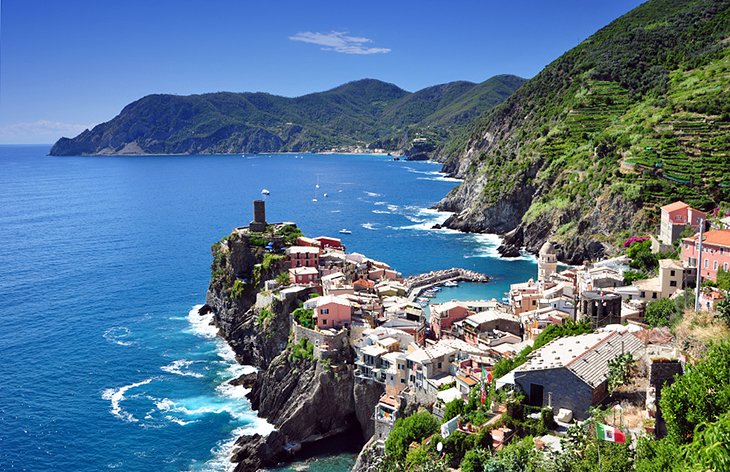Main sights in Vernazza
Doria Castle – built in the 15th century as a lookout tower to protect the village from pirates
Vernazza beach
Church of Santa Margherita d’Antiochia, circa 1318. Unique for its east-facing entryway, it has a nave and two aisles, with an octagonal bell tower rising from the apse area, and is located in the town’s main square Piazza Marconi
Corniglia
Corniglia is a fraction of the commune of Vernazza in the province of La Spezia, Liguria, northern Italy. Unlike the other localities of the Cinque Terre, Corniglia is not directly adjacent to the sea. Instead, it is on the top of a promontory about 100 metres high, surrounded on three sides by vineyards and terraces and the fourth side descends steeply to the sea. The derivation of the town dates back to the Roman Age as shown by the name which finds its roots in Gens Cornelia, the Roman family to whom the land belonged. In the Middle Ages it was a possession of the counts of Lavagna, the lords of Carpena and of Luni. In 1254 Pope Innocent IV gave it to Nicolò Fieschi, who held it until 1276, when the village was obtained by the Republic of Genoa.
Manarola, Cinque Terre, Italian Riviera. This file is licensed under the CC Attribution-Share Alike 3. 0 Unported. Author: chensiyuan
Manarola
Manarola is a small town, a frazione of the comune of Riomaggiore, in the province of La Spezia, Liguria, northern Italy. It is the second smallest of the famous Cinque Terre towns frequented by tourists. The current village dates back to the 12th century, when the number of residents started to grow due to immigration from the village of Volastra, located higher up. Manarola was ruled by the Lords of Carpena and by the Fieschi Family, until in 1276 it was subdued by Genoa. The houses are in part grouped on a rocky outcrop and in part aligned along the valley of the Rio di Grippo stream. The historical buildings are concentrated in a pretty square situated in a commanding position. Manarola may be the oldest of the towns in the Cinque Terre, with the cornerstone of the church, San Lorenzo, dating from 1338. Manarola’s primary industries have traditionally been fishing and wine-making. The local wine, called Sciacchetrà, is especially renowned; references from Roman writings mention the high quality of the wine produced in the region. In recent years, Manarola and its neighboring towns have become popular tourist destinations, particularly in the summer months. Mostly all of the houses are bright and colourful. Manarola was celebrated in paintings by Antonio Discovolo (1874-1956).
Photo details: Uploaded on May 4, 2012 © All Rights Reserved by Fabio Peruzzi

Main sights in Manarola
The famous walking trail between Manarola and Riomaggiore (called Via dell’Amore – «Love’s Trail») and hiking trails in the hills and vineyards above the town. The Via dell’Amore (Lovers’ Lane) is a well-paved coastal path linking Manarola with Riomaggiore (1km/0. 6mi). Studded with picnic areas and stone beaches embedded in the cliffside, it affords stunning sea views. At either end, steps lead up from the train station to the path – checkpoints along the way ensure no one sneaks by without a valid trail pass. The Via dell’Amore is part of the 12km-long (7. 4mi) sentiero azzurro (blue trail) that runs the length of the coast between Monterosso and Riomaggiore. Unlike Lovers’ Lane, which is flat, well-paved and suited to walkers of all abilities, the rest of the footpath is only for the sure-footed and well-equipped.
Houses on the rocks, Riomaggiore, Cinque Terre, Italian Riviera. July 2012. Photo by © Cosmin R Roman.
Riomaggiore
Riomaggiore is a village and comune in the province of La Spezia, situated in a small valley in the Liguria region of Italy. It is the first of the Cinque Terre one meets when travelling north from La Spezia. Riomaggiore is the most southern village of the five Cinque Terre, all connected by trail. The water and mountainside have been declared national parks. Riomaggiore inspired paintings by Telemaco Signorini (1835-1901), one of the artists of the Macchiaioli group. According to the tradition, the origin core would have been founded in the 7th century by a group of Greek refugees, at the site of the current small village of Montenero, located up the hill. After the main urban center shifted toward the coastline, it was ruled by various feudal families, such as the Turcotti, lords of Ripalta and Cericò, and the Fieschi, until in 1276 it felt under the domination of the Republic of Genoa, like the others villages of Cinque Terre.



